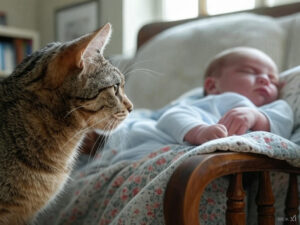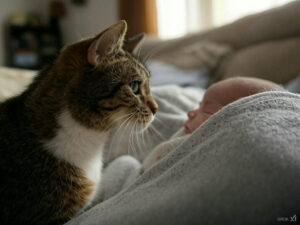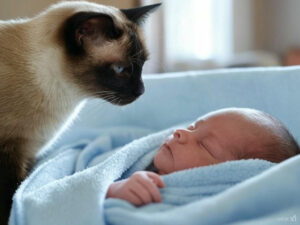Comprehensive Guide to Safely Introducing Your Newborn to Your Cat
Cats are complex and captivating creatures, often exhibiting behaviors that can be puzzling for their human companions. To facilitate a seamless transition during the arrival of your newborn, it is crucial to understand these unique behaviors. Cats are naturally territorial, making their environment a key factor in their emotional well-being and stability. By gaining a thorough understanding of your cat’s needs and preferences, you can create a nurturing atmosphere that accommodates both your feline friend and your newborn, ensuring a harmonious coexistence from the very start.
Felines communicate through a rich combination of body language, vocalizations, and scent marking, all of which can be greatly affected by changes in their environment. When a new baby arrives in the home, your cat may display signs of stress or anxiety in response to unfamiliar sounds and scents. Being able to recognize these signals—such as hiding, excessive grooming, or changes in eating habits—empowers owners to effectively respond to their cat’s needs during this critical transition period. This awareness can significantly enhance the bond between you and your pet during this time of change.
Moreover, cats thrive on routine and familiarity, which makes them particularly susceptible to disruptions caused by the arrival of a newborn. The introduction of a baby can disturb established patterns, leading to noticeable behavioral changes. For example, a cat that previously enjoyed lounging in a specific area may start to avoid it if it becomes associated with the baby. Understanding these intricate behaviors is crucial for fostering a peaceful coexistence between your cat and your newborn, allowing both to adapt to their new realities with minimal stress.
Essential Strategies for a Smooth Transition with Your Cat and New Baby
- Understanding your cat’s behavior is essential for preparing for the arrival of your newborn.
- Implementing gradual adjustments to your cat’s routine can facilitate a smoother transition and alleviate anxiety.
- Introducing your cat to the baby’s scent in advance can help foster familiarity.
- Ensure all introductions between your cat and the baby are safe and supervised to encourage positive interactions.
- Establishing clear boundaries for your cat around the baby is vital for creating a harmonious living environment.

Proven Techniques to Prepare Your Cat for the Arrival of a Newborn
Preparation plays a pivotal role in ensuring a smooth transition for your cat as you welcome a new baby into your home. One of the first steps involves gradually introducing changes to your home environment that will take place once the baby arrives. This preparation may include setting up the nursery and bringing in essential baby items like cribs, strollers, and toys that will soon become part of your daily life.
Allowing your cat to explore these new items prior to the baby’s arrival can significantly reduce anxiety and help them adjust to the upcoming changes with greater ease. For instance, placing the baby’s belongings in areas where your cat typically spends time can facilitate their acclimatization to the new scents and sights. Additionally, it is crucial to maintain your cat’s established routine as much as possible during this transitional phase to promote stability and security.
Cats thrive on consistency; thus, keeping regular feeding times, play sessions, and cuddle moments can provide them with a sense of normalcy amidst the changes. If you anticipate significant alterations to your daily schedule after the baby’s arrival, consider gradually modifying your cat’s routine beforehand. This proactive approach can help minimize feelings of neglect or confusion that your cat may experience when the baby inevitably becomes the center of attention in the household.
Effective Ways to Introduce Your Cat to the Baby’s Unique Scent
After adequately preparing your cat for your newborn’s arrival, the next important step is introducing them to the baby’s unique scent. Cats have an exceptional sense of smell and heavily rely on this ability to interpret their environment. To facilitate this introduction, you can bring home a blanket or an item of clothing that has been in close contact with the baby.
It is essential to encourage your cat to sniff and explore this item at their own pace. This process helps them associate the new scent with something familiar and non-threatening. In addition to using clothing or blankets, consider utilizing pheromone diffusers or sprays designed specifically for cats. These products can create a calming atmosphere, which may help alleviate your cat’s anxiety regarding the new addition to the family.
Combining these methods will foster a positive association with the baby’s scent, making it easier for your cat to accept the new family member when they finally meet face-to-face. This gradual introduction is a key component in assisting your cat in adjusting to the changes in their environment and ensuring they feel secure.

Guidelines for Safe and Supervised Introductions Between Your Cat and Baby
The initial meeting between your cat and the newborn should be approached with utmost care and consideration to ensure a safe and positive experience for both. Supervised introductions are vital for guaranteeing the safety of both your baby and your feline companion, as well as fostering a positive relationship from the very beginning. When you feel the time is right for this initial meeting, select a calm and relaxed moment for both your cat and baby.
It is advisable to hold your baby securely in your arms while seated on a comfortable surface where your cat can approach at their own pace. During this introduction, pay close attention to your cat’s body language. Signs of curiosity may include slow blinks or gentle sniffing, while signs of distress could manifest as hissing or an arched back.
If your cat shows signs of anxiety or discomfort, it is crucial to give them space and allow them to retreat if they wish. This approach respects your cat’s boundaries and helps them feel more secure in their environment. Over time, with consistent positive interactions, your cat will likely become more comfortable and accepting of the baby, creating a strong foundation for their future relationship.
Setting Clear Boundaries and Rules for a Harmonious Environment
Establishing clear boundaries and rules is essential for maintaining a peaceful coexistence between your cat and your newborn. As your baby grows and begins to explore their surroundings, teaching them how to interact safely with your cat becomes increasingly important. This includes explaining that pulling tails or grabbing fur is unacceptable behavior that should be avoided at all costs.
Teaching your child the significance of gentle touch early on can help prevent unintentional harm to either the cat or the baby. Alongside educating your child about appropriate interactions with the cat, setting boundaries for your cat is equally critical. For instance, designating certain areas of the home as off-limits for the cat—such as the nursery—will help create a secure space for both your baby and your feline friend.
Utilizing baby gates or closed doors can effectively establish these boundaries while allowing each party to have their own space. This proactive measure will benefit both your cat and your newborn as they learn to navigate their shared environment, promoting safety and comfort for everyone involved.

Designing Secure and Comfortable Spaces for Your Cat Amidst New Changes
Creating safe spaces for your cat is essential in ensuring they feel secure during the adjustments that come with a new baby. Cats often seek quiet and secluded areas when feeling overwhelmed or stressed. Providing designated spaces—such as cozy beds or elevated perches—can give your cat a sense of ownership over their environment and a place to retreat when needed.
In addition to creating physical spaces, consider incorporating elements that cater to your cat’s natural instincts. Scratching posts, climbing trees, and interactive toys can provide mental stimulation and physical activity, serving as effective outlets for any pent-up energy or anxiety. Enhancing your cat’s environment in this manner promotes their overall well-being and aids in their adjustment process with the new baby, ensuring they remain happy and engaged.
Monitoring and Interpreting Your Cat’s Behavior Around the Baby
As your baby matures and starts to explore their environment more actively, it becomes increasingly vital to closely monitor your cat’s behavior around them. Cats can be unpredictable, and even the most docile feline may react unexpectedly when startled or provoked. Regularly observing the interactions between your cat and baby will enable you to identify potential issues before they escalate into problems.
Be vigilant for signs of stress or discomfort in your cat during these interactions. If you observe any aggressive behavior or indications of fear—such as hiding or avoiding contact—it may be necessary to intervene and separate them temporarily. This proactive approach not only protects both parties but also reinforces positive associations over time as they learn to coexist harmoniously, fostering a safe environment for both your cat and your newborn.
Effective Strategies for Cultivating a Positive Relationship Between Your Cat and Newborn
Fostering a positive relationship between your cat and newborn is an ongoing journey that requires patience and consistency. Engaging both parties in shared activities can significantly strengthen their bond over time. For instance, allowing your baby to partake in supervised feeding sessions can create shared experiences that foster familiarity and trust between them.
Additionally, incorporating playtime into their interactions can be beneficial for both your cat and baby. Utilizing toys that promote gentle play can help establish positive associations while allowing both parties to engage in enjoyable activities together. As your child grows, teaching them to respect boundaries while interacting with the cat will further solidify their relationship, paving the way for a harmonious dynamic.
Building a harmonious relationship between your cat and newborn requires time and effort, but the rewards can be immense. By understanding feline behavior, preparing adequately for changes, and encouraging positive interactions, you can create an environment where your cherished pet and new family member can thrive together in love and companionship.
Common Questions About Introducing a Newborn to Your Cat
What is the most effective way to introduce a newborn to a cat?
The most effective method for introducing a newborn to a cat involves allowing the cat to become familiar with the baby’s scent before the baby arrives home. Once your baby is home, it’s essential to supervise all interactions between your cat and the newborn to ensure safety for everyone involved.
How can I adequately prepare my cat for the arrival of a newborn?
To prepare your cat for the arrival of a newborn effectively, gradually introduce changes to their routine, such as relocating their feeding and sleeping areas to the baby’s room. Additionally, playing recordings of baby sounds can help your cat acclimate to the new noises they will soon encounter.
What warning signs may indicate my cat is struggling to adjust to the newborn?
Indicators of potential adjustment issues for your cat may include aggressive behavior, excessive hiding, or noticeable changes in eating or grooming habits. If you observe any concerning behaviors, it’s essential to consult with a veterinarian or an animal behaviorist for professional guidance to ensure your cat receives the support they need.
How can I promote a positive relationship between my cat and newborn?
To facilitate a positive relationship between your cat and newborn, ensure your cat continues to receive sufficient attention and affection, even after the baby arrives. Additionally, create safe zones for the cat to retreat to when they need a break from the baby’s presence, allowing them to feel secure and comfortable.
What important precautions should I take when introducing my newborn to my cat?
Key precautions when introducing your newborn to your cat include keeping the cat’s claws trimmed, never leaving the baby unattended with the cat, and teaching your baby to be gentle and respectful towards the cat to prevent any potential issues.
The Article : How to Introduce a Newborn to a Cat Appeared First On Unity Pets.
The Article Introducing a Newborn to a Cat: Tips for a Smooth Transition Was Found On https://limitsofstrategy.com

